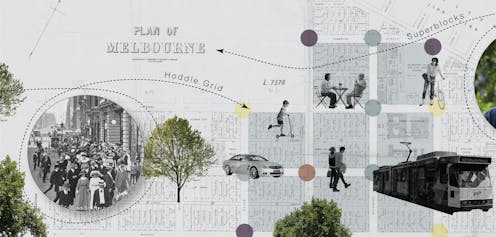How superblocks can free up and improve CBD space for the people of Melbourne – a step-by-step guide
- Written by Marco Amati, Associate Professor of International Planning, Centre for Urban Research, RMIT University

For 185 years, Melbourne’s Hoddle Grid[1] – the ordered layout of CBD streets and blocks designed in 1837 – has dictated the flow of people and vehicles in the city centre. But how well does the grid serve 21st-century needs?
Melbourne faces three interconnected challenges that conflict with a business-as-usual, car-based grid. These are: how to end the dominance of cars; how to respond to the reality of the city centre as a residential area; and how to “reignite[2]” post-pandemic activity in the CBD.
Superblocks are an approach, pioneered in Barcelona[3], to making urban areas more liveable and people-friendly.
A superblock covers an area of multiple city blocks – typically nine in a 3x3 format – that excludes through traffic. In this space, cyclists, walkers and residents have priority, though cars still have low-speed access to all buildings within the area. Superblocks transform formerly car-dominated streets into public spaces that can be used for a range of activities.
We have developed a step-by-step approach to introducing superblocks to Melbourne.

















